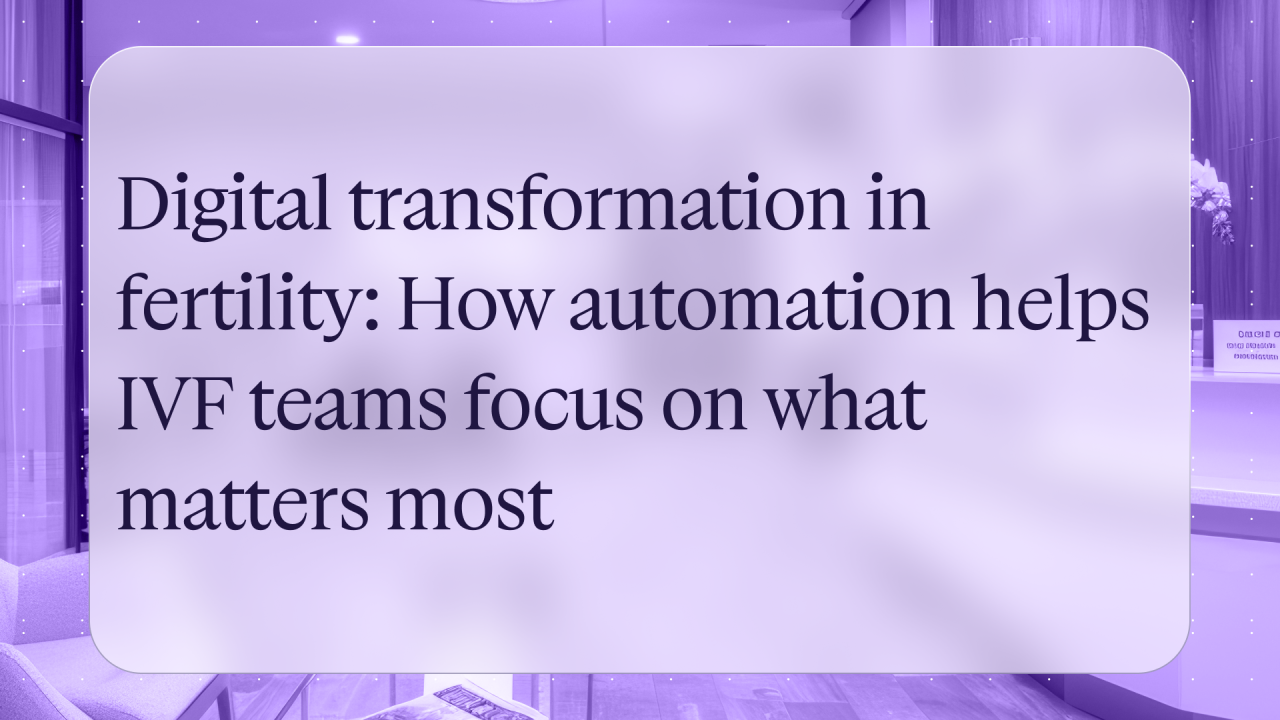Digital transformation in fertility: How automation helps IVF teams focus on what matters most

Delivering exceptional fertility care relies on two things: clinical precision and compassionate patient support. But when frontline teams are overwhelmed by manual admin, it becomes harder to deliver either.
From chasing forms to confirming appointments, too many highly skilled professionals are spending their time on repetitive tasks that technology could handle- quietly and reliably.
Digital transformation is often talked about in terms of software. But for fertility clinics, it’s ultimately about one thing: giving teams more capacity to do the work that truly matters.
Here’s how smart automation is making that possible.
1. Manual admin adds pressure and risk
When essential tasks like data entry, reminders or lab handovers are handled manually, things inevitably slip. This affects not just efficiency but safety and consistency across the patient journey.
Admin overload can lead to:
- Delayed updates
- Overlooked details
- Poor communication between departments
Automation helps reduce this risk by taking care of routine processes—consistently, accurately, and with fewer handovers.
2. Clinic comms should be consistent, not dependent on memory
Patients undergoing IVF need reassurance and clear direction at every stage. But when communication relies on team members remembering to call, email or follow up, it’s vulnerable to delays.
Automated messaging means patients receive timely updates—without additional effort from already stretched staff. It builds consistency into your care model and reduces the risk of someone falling through the cracks.
3. The onboarding experience sets the tone for care
Getting started with treatment should feel straightforward—not like navigating a mountain of paperwork.
Many clinics still manage patient onboarding through emailed forms, manual ID checks and follow-up calls. Not only does this slow down the process, it creates space for errors and frustration.
Digitising and automating these steps speeds up onboarding while improving accuracy and transparency, for both patients and staff.
4. Staff workflows need the same attention as patient ones
Automation isn’t just for patient-facing tasks. It also plays a crucial role in internal coordination.
When departments manage tasks via email, spreadsheets or verbal updates, gaps form. Results go unflagged, handovers get missed, and progress tracking becomes unreliable.
Well-designed automation triggers tasks at the right time, keeps statuses up to date, and ensures information flows smoothly between teams.
5. Supporting staff starts with reducing unnecessary workload
Highly trained professionals bring enormous value to fertility clinics. But when they’re stuck repeating the same admin tasks day after day, that value is lost.
The real power of automation lies in giving people space to do more impactful work- whether that’s guiding patients, improving care pathways or innovating on service delivery.
It’s not about cutting corners. It’s about working smarter so your team can lead, support and care more effectively.
What automation can look like in practice
A modern, well-automated fertility clinic might:
- Send appointment reminders automatically
- Collect and validate digital forms ahead of visits
- Track consent status without manual chasing
- Trigger next steps once a treatment milestone is reached
- Show real-time progress to both staff and patients
- Keep patients informed at every step—without requiring extra calls or emails
The goal isn’t to replace people- it’s to empower them.
With fewer repetitive tasks and more streamlined workflows, IVF teams can focus on care, not process.
At Salve, we work with clinics to embed automation in a way that enhances clinical work—not replaces it. The result? Less stress, more control, and better experiences for both staff and patients.

.png)



.jpg)





